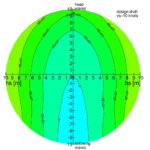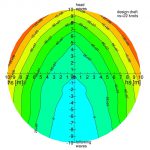DNV GL has developed a precise 3D Rankine singularity method code which was expanded into a tool for the assessment of course-keeping and added power requirements.
Seakeeping considers the response of ships and offshore structures in waves. It is of fundamental importance for the operation of[ds_preview] ships and also during the design of many ship types. Tools to predict seakeeping are:
Model tests (time-consuming and expensive; rarely performed for commercial ship projects);
Full-scale measurements on board ship whilst at sea (problematic due to external »noise« in the measurement, but increasingly performed; adding engineering intelligence in the form of theoretical seakeeping models can improve the accuracy of these experiments);
Computations in the frequency domain: determination of ship response to harmonic waves of different wave lengths and wave directions (most popular approach; efficient in computation, but limited accuracy as nonlinear physics must be approximated by linear computational models);
Computations in the time domain, i. e. simulation in time (increasingly used, but computationally expensive; only short simulations of the order of several seconds to minutes are currently achievable in a reasonable time frame).
Statistical long-term assessment based on linear frequency domain computations (for given seaway or given ocean region, based on probability of occurrence of seaways – wave atlas).
Bertram and Couser (2014) survey various computational seakeeping methods and associated software tools with the purpose of giving a roadmap for non-experts. An extract of this paper is given here with particular focus on added resistance, as this plays a key role in hull performance management, route optimization and other fuel efficiency applications.
Don’t believe the hype!
With appropriately chosen problems, all methods work well. It is for this reason that we always see »good agreement« with experiments or other computational methods published. But most publications show results only for heave and pitch motions, and this for several reasons:
Heave and pitch motions are relatively well predicted even by simpler theoretical models.
Many experimental facilities can test models in head or following seas, few in oblique waves. Therefore, model test data is more readily available for ships in head waves (where heave and pitch motions dominate) than in oblique waves.
Reality is much more complex and difficult. Roll motion is highly nonlinear with significant viscous effects. Yaw motions depend on the rudder action, particularly at low frequencies.
Without a coupled autopilot maneuvering module, motions (and subsequently added resistance) may be over-predicted. And ships with large transom sterns (i. e. all modern container ships) have complex flows detaching from the sharp geometric transition at the transom. Despite these complications, most methods give acceptable results for motions. The accurate prediction of added resistance is however much more complicated.
It is often argued that head waves present the most critical case. This is not true, at least not in general. In our experience with real containership geometries, the highest added resistance occurs for slightly oblique waves, say 10°–20° off head waves. However, consideration of only head waves simplifies the computations considerably and may be a pragmatic engineering approach for many applications when only a reasonable estimate is needed (adding e.g. 10% for the maximum in slightly oblique waves) or when two alternatives (hull shapes, routes, etc.) are compared.
Several historical methods for added resistance in waves omit part of the physics to simplify the resulting formula, e.g. the diffraction parts or the parts from ship motions. Such omission of terms can be justified for certain subsets of problems, e.g. very large ships in short waves, or slender ships in head seas. Unfortunately such approaches, derived for a range of specific problems, are frequently used beyond their realm of applicability. Therefore we advocate using generalised methods which are applicable to a broad range of problems.
Various analytical and semi-empirical formulas to estimate added resistance in waves have been proposed, e. g. Alexandersson (2009). These approaches use basic geometric parameters to give the added resistance directly. One of the oldest and simplest of these »magic« approaches dates back to Kreitner (1939), as given by ITTC (2005), »as recommended for sea trials« (albeit only up to sea state 2 which is often conveniently overlooked). The temptation to use such simple approaches is understandable: With very little effort the desired quantity is obtained. However, the old adage applies: If something sounds too good to be true, it probably is.
Nabergoj and Prpi -Orši (2007) compared five of these simple approaches for a RoRo vessel, with large scatter of results (factor of four between lowest estimate and highest estimate).
Perez Arribas (2006) discusses various semi-analytical approaches and compares three in more detail against model tests for a ship in head waves. Results scatter by factor of three.
Boom et al. (2008,2013) compare a different set of empirical wave correction methods coming to the same conclusion: »The results were shockingly different.«
We tested the Kreitner formula for a containership comparing against computational simulations, finding differences of 20–110%.
There simply is no formula which gives the added resistance in waves for all ship types with good accuracy.
Silver lining on the horizon
Despite active research, added resistance in seaways has eluded accurate prediction in short waves ( /L < 0.5) for decades. Both model tests and numerical simulations have shown large scatter in results. The difficulties explaining the sobering results for shorter waves are:
1. A general difficulty for model tests is that the added resistance, which is the time average of the oscillating longitudinal force, is small compared with the amplitude of the oscillations. Thus, errors in the measurement and averaging of the force over time may be comparable to or even exceed the average force itself. In addition, added resistance is sensitive to the quality of the generated waves and their measurement.
2. CFD simulations face problems due to grid resolution for analyses in short waves. For short waves, the approximate method of Faltinsen et al. (1980) is frequently used. This approach assumes that the wave length is negligible compared to ship draft. In our experience, this method works very well for full hull forms at scantling draft, but not for ships and loading conditions where wave length to draft ratio is not very large, e. g. for container carriers and cruise vessels (at all drafts) and full vessels at ballast draft.
Söding et al. (2012) presented GL Rankine, a relatively new 3D Rankine singularity method (RSM) code. The years 2012 and 2013 have seen extensive internal validation of the code at then FutureShip (now DNV GL Maritime Services). Progress in code efficiency and parallel computing power changed track in our abilities to compute added resistance in short waves, using, typically, 2,500 panels on the hull and up to 20,000 panels on the free surface (in each case on the starboard half only). The fine mesh size allows computing wave lengths as short as /L = 0.1, covering the whole range of practically relevant wave lengths without having to resort to extrapolation.
However, added resistance in regular waves is not enough to come to correct decision for design and operation in practice. Therefore, GL Rankine was expanded into GLcourse, a tool for the assessment of course-keeping and added power requirements (respectively achievable speed) in seaways. GLcourse covers the following aspects of added power in natural seaways:
Transfer functions of added resistance from GL Rankine;
Consideration of wind direction and speed;
Arbitrary spectrum of natural seaway, including wind sea, swell or combination;
Added resistance due to manoeuvring forces compensating for drift angle (hull forces and rudder forces);
Consideration of propeller and engine dynamics.
Since late 2013, the tool has been applied in several commercial projects while research projects proceed with continued validation studies. A current research project combines GL Rankine with the Friendship Framework for formal optimization of ships in seaways.
References
Bertram, V.; Couser, P. (2014), Computational Methods for Seakeeping and Added Resistance in Waves, 13th Conf. Computer and IT Applications in the Maritime Industries (COMPIT), Redworth, pp. 7-17
Boom, H.v.d.; Hout, I.E. v.d.; Flikkema, M. (2008), Speed-power performance of ships during trials and in service, SNAME
Boom, H.v.d.; Huisman, H.; Mennen, F. (2013), New guidelines for speed/power trials level playing field established for IMO EEDI, Hansa 4/2013, p. 58
Faltinsen, O. M.; Minsaas, K. J.; Liapis, N.;
Svein, S. O. (1980), Prediction of resistance and propulsion of a ship in a seaway, 13th Symp. Naval Hydrodynamics, Tokyo, pp. 505-529
ITTC (2005), Full scale measurements – Speed and power trials – Analysis of speed/power trial data, Recommendations of the 24th Int. Towing Tank Conf., Edinburgh
Kreitner, J. (1939), Heave, pitch and resistance of ships in a seaway, Trans. Institution of Naval Architects 81
Nabergoj, R.; Prpi -Orši , J. (2007), A comparison of different methods for added resistance prediction, 22nd Int. Workshop Water Waves and Floating Bodies, Plitvice
Perez Arribas, F. (2007), Some methods to obtain the added resistance of a ship advancing in waves, Ocean Eng. 34/7, pp. 946-955
Söding, H.; Shigunov, V.; Schellin, T. E.; Moctar, O. (2012), A Rankine panel method for added resistance of ships in waves, 31st Int. Conf. Ocean, Offshore and Arctic Eng. (OMAE), Rio de Janeiro
Author: Volker Bertram, DNV GL
Hamburg, volker.bertram@dnvgl.com
Volker Bertram




















